Franschhoek: new hope for land
Story and photos © Stephan Hofstatter
21 July 2005
Mooiwater farm near the Western Cape village of Franchhoek was once a thriving apple and plum orchard. Now it is the site of a low-cost housing development that's home to over 1 000 families.

To some this is a sign of how political pressure brought to bear by squatters can lead to prime agricultural land being used for settlement. Others have hailed the formal township, and the luxury wine estate that subsided its construction, as an elegant compromise between the rights of land owners and the landless.
It has led to a dramatic drop in racial tension in the area, and could become a model for sustainable land reform in South Africa.
Former Mooiwater owner Clive Garlic has mixed feelings. "It was a really good place to farm," he says. "There was plenty of water and the soils were good and well drained." But he doesn't regret his decision to accept the council's
offer of R6-million for the land, which by the late 1990s had become some of the most sought-after real estate in the country.
"I'm glad I'm out of farming," said Garlic, who now lives with his family in Franschhoek village. "The best thing I could do was sell it."
Removals and invasions
Mooiwater is next to what the apartheid government designated the "coloured" neighbourhood of Groendal, a dumping ground for victims of families forcibly removed from "white" areas in the 1960s.
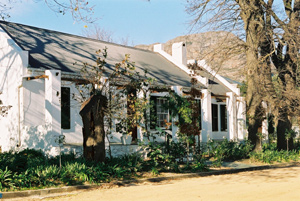 One of the historic houses in the white Franschhoek neighbourhood from which coloured familes were forcibly removed in the 1960s. These houses are now worth millions.
One of the historic houses in the white Franschhoek neighbourhood from which coloured familes were forcibly removed in the 1960s. These houses are now worth millions.
Garlic started farming at Mooiwater in 1991. Three years later, in 1994, South Africa held its first democratic elections. Many Groendal residents living in backyards shacks and evicted farmworkers
decided vacant land was now theirs for the taking. The closest open plot lay directly beneath Garlic's farm. The new squatter camp posed a serious threat to Garlic's farm and family.
"They stole my fruit, cut my poles and steel wire. I never walked around unarmed and I had to hire private security guards," he recalled. "We had many confrontations. I have three daughters and they were really scared."
From Vietnam to Mooiwater
The new Mooiwater settlement is a far cry from the raucous crime-infested squatter camp dubbed Vietnam by shack dwellers because it reminded them of the waterlogged jungles they'd seen in war movies. Back then, Vietnam was not a place the casual visitor ventured into unaccompanied.
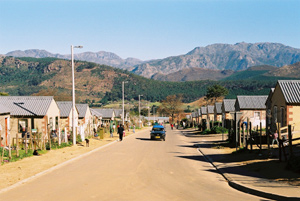 There's a peaceful ambience in Mooiwater village, where the houses and streets are neatly planned.
There's a peaceful ambience in Mooiwater village, where the houses and streets are neatly planned.
Today a friendly, orderly atmosphere prevails
in Mooiwater. Its neatly laid out streets are lined with electric lighting and filled with kids playing soccer and teenagers chatting while their parents hang out washing. There is no sign of sinister street hoods or drug barons cruising the streets in cars with tinted glass.
The quaint, solidly constructed ochre and mustard cottages designed by Dennis Moss, one of the country's leading architects, are all equipped with flush toilets, running water and electricity. Squatters had the option to get a free basic structure worth R38 000 - R20 000 more than a traditional RDP (Reconstruction and Development Programme) house - or pay extra for a double-storey, extended or semidetached home.
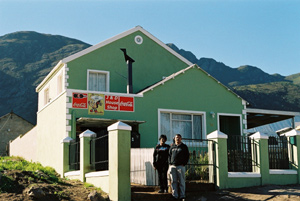 Joanna and Davy Sias outside their double-storey house in Mooiwater.
Joanna and Davy Sias outside their double-storey house in Mooiwater.
In return for title deeds and keys to their new homes, the squatters had to
dismantle their shacks and agree not to support illegal squatting or backyarding, pay for services and foreswear crime.
Construction of this upmarket township on prime land was partly the result of efforts by the squatters themselves and a group of land claimants who'd been booted out of historic houses in what became the white side of town.
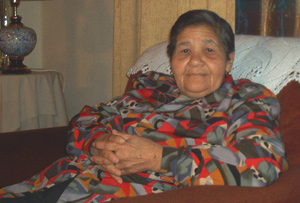 Benjamina Paulse is Franschhoek's last surviving victim of apartheid-era forced removals. Over 40 coloured families were forcibly removed from the town in the 1960s.
Benjamina Paulse is Franschhoek's last surviving victim of apartheid-era forced removals. Over 40 coloured families were forcibly removed from the town in the 1960s.
Both communities were initially eyeing the 100ha municipal commonage that straddles the gentle slopes above an upmarket suburb on the opposite end of the valley. They reasoned that the government owed them land, the commonage belonged to the council, so it should be given to them.
The
deal is struck
Under pressure from wealthy whites fearing plummeting land values and full-scale land invasions, the council decided to sell off its commonage to Chris Hellinger, owner of neighbouring wine estate Chamonix.
The communities managed to interdict the sale, and so began a tussle that ended with the signing of a social accord in 1998, whereby all parties agreed that the commonage could be sold and developed on condition that some of the proceeds went to settling the land claims, provided housing for the squatters and bankrolled black economic empowerment.
Funding the construction of Mooiwater had always been beyond the financial means of Franchhoek's town council. Paying for the land alone would have eaten more than half its R11-million annual operating budget.
By selling the commonage for R14-million to a corporate consortium, the council not only unlocked French funding and a loan from the Development Bank of SA (DBSA) but was able to top up national
housing department grants and thereby provide far superior accommodation.
The deal went further. The consortium - which includes prominent local residents, the V&A; Waterfront Company and Pam Golding Properties - is developing the commonage into a luxury wine estate and tourism centre expected to have major empowerment spinoffs, as well as up-market riverside and village residential units.
The entire complex was specifically designed by Moss, the Mooiwater architect, to ensure that "the rich man's house and the poor man's house are cousins" as a way of reducing crime and diffusing racial and political tensions. A key design feature was replicating the low walls of Cape Dutch architecture and encouraging a shared sense of belonging.
"If you surround your house with high walls there is no transparency," Moss says. "Streets become negative spaces. You can kill there because it's no longer yours."
Buyers of plots will be able to engage their own architects to design their
homes but are bound by Moss's guidelines, which cover anything from building materials to roof pitch. Security will be provided by a local black-owned company with a control room on the estate and electronic surveillance.
"We don't want to be a gated white community with people living in a quasi-European neverland, but there must be security," says investor and marketing manager Peter Middleton.
"The disparities are greater here than anywhere in the country. If it can work here, it can work anywhere."
The development trust
In return for a slice of disputed but valuable government real estate, the developers agreed to pay a 1% levy on every plot sold and 0.25% for resales. The money goes into a trust to improve the lives of Franschhoek's poor and fund nature conservation efforts. The trust, chaired by Nelson Mandela Foundation head John Samuel, is controlled by local activist leaders, land claims representatives and environmentalists.
Samuel himself
has shares in the project, together with another prominent political figure, former US ambassador Franklin Sonn.
"I acted as a midwife to make sure the community were adequately consulted and compensated," Samuel says. "When I took the idea to [former president Nelson] Mandela, he was thrilled."
Sonn, who chairs the consortium, denies this represented a conflict of interest. "The trouble with developers is they're often only concerned with the bottom line, not with what they leave behind," he says. "Having a stake gives you the power to make them understand what needs to be done. But in this case I pushed at open doors."
Consortium CEO Willem Steenkamp says shareholders have so far contributed about R20-million in equity and loans and netted another R16-million from land transactions. This has allowed access to a R1-million planning grant and two loans totalling R52-million from the DBSA. Both loans must be repaid at commercial rates.
The first will fund bulk
infrastructure on the commonage normally paid for by municipalities, such as water reservoirs, link roads and upgrading electricity substations. Steenkamp says the developers are only expected to repay the loan once earning income and can count this as their mandatory developers' contribution, which is usually about R3-million for a project this size.
Furthermore, in terms of a complex written agreement, the developers will be able to claim back about 20% of their expenditure through service charge rebates, and the municipality is obliged to maintain the infrastructure.
"In a sense we're secure bridging finance for the municipality's capital outlay. It couldn't finance this operating structure," says Steenkamp.
Weekend farmers
Although some stands have already been sold, the properties will only be formally marketed early in 2006. The developers hope to generate about R700-million gross within two years once all plots are sold and make a profit of
R100-million.
Half the buyers are expected to be foreign and the rest to range from Cape peninsula executives to Gauteng pensioners. The most expensive units - an acre surrounded by vineyards going for US$900 000 (about R6-million), excluding construction costs - are designed for wealthy weekend farmers willing to pay for a wine farm ambience without getting their hands dirty.
Title deeds will record that the surrounding land must remain zoned for agriculture in perpetuity and cannot be subdivided.
The second loan - over R10-million - financed the farm infrastructure, including vineyards. Cultivars being planted on 24 hectares of the total estate include Cabernet, Merlot, Shiraz, Savignon Blanc and Chardonnay.
"The estate has a variety of sites - mountain and valley - with different soil types," says agricultural developer Dirk le Roux. "We were able to select the optimal site for each cultivar and expect very good wines to be made there."
Planting will be over by
the end of spring and the first wines will be bottled within three years. Output is expected to be about six tons a hectare. "We're going for the top end of the market, so the emphasis will be on quality, not quantity."
It remains to be seen whether wealthy buyers will bite and if real black empowerment will result, but so far the signs are encouraging.
"We have every reason to be optimistic that this will be a success," says Steenkamp.
Stephan Hofstatter is a specialist land correspondent, contributing to Independent Newspapers, Business Day and Farmer's Weekly, among others.
Story and photographs strictly copyright Stephan Hofstatter. No reproduction is permitted without prior permission.
This article was originally published in Farmer's Weekly, South Africa's premier national agricultural magazine, and is reproduced on SouthAfrica.info with kind permission.
 To some this is a sign of how political pressure brought to bear by squatters can lead to prime agricultural land being used for settlement. Others have hailed the formal township, and the luxury wine estate that subsided its construction, as an elegant compromise between the rights of land owners and the landless.
It has led to a dramatic drop in racial tension in the area, and could become a model for sustainable land reform in South Africa.
Former Mooiwater owner Clive Garlic has mixed feelings. "It was a really good place to farm," he says. "There was plenty of water and the soils were good and well drained." But he doesn't regret his decision to accept the council's
offer of R6-million for the land, which by the late 1990s had become some of the most sought-after real estate in the country.
"I'm glad I'm out of farming," said Garlic, who now lives with his family in Franschhoek village. "The best thing I could do was sell it."
Removals and invasions
Mooiwater is next to what the apartheid government designated the "coloured" neighbourhood of Groendal, a dumping ground for victims of families forcibly removed from "white" areas in the 1960s.
To some this is a sign of how political pressure brought to bear by squatters can lead to prime agricultural land being used for settlement. Others have hailed the formal township, and the luxury wine estate that subsided its construction, as an elegant compromise between the rights of land owners and the landless.
It has led to a dramatic drop in racial tension in the area, and could become a model for sustainable land reform in South Africa.
Former Mooiwater owner Clive Garlic has mixed feelings. "It was a really good place to farm," he says. "There was plenty of water and the soils were good and well drained." But he doesn't regret his decision to accept the council's
offer of R6-million for the land, which by the late 1990s had become some of the most sought-after real estate in the country.
"I'm glad I'm out of farming," said Garlic, who now lives with his family in Franschhoek village. "The best thing I could do was sell it."
Removals and invasions
Mooiwater is next to what the apartheid government designated the "coloured" neighbourhood of Groendal, a dumping ground for victims of families forcibly removed from "white" areas in the 1960s.
 One of the historic houses in the white Franschhoek neighbourhood from which coloured familes were forcibly removed in the 1960s. These houses are now worth millions.
Garlic started farming at Mooiwater in 1991. Three years later, in 1994, South Africa held its first democratic elections. Many Groendal residents living in backyards shacks and evicted farmworkers
decided vacant land was now theirs for the taking. The closest open plot lay directly beneath Garlic's farm. The new squatter camp posed a serious threat to Garlic's farm and family.
"They stole my fruit, cut my poles and steel wire. I never walked around unarmed and I had to hire private security guards," he recalled. "We had many confrontations. I have three daughters and they were really scared."
From Vietnam to Mooiwater
The new Mooiwater settlement is a far cry from the raucous crime-infested squatter camp dubbed Vietnam by shack dwellers because it reminded them of the waterlogged jungles they'd seen in war movies. Back then, Vietnam was not a place the casual visitor ventured into unaccompanied.
One of the historic houses in the white Franschhoek neighbourhood from which coloured familes were forcibly removed in the 1960s. These houses are now worth millions.
Garlic started farming at Mooiwater in 1991. Three years later, in 1994, South Africa held its first democratic elections. Many Groendal residents living in backyards shacks and evicted farmworkers
decided vacant land was now theirs for the taking. The closest open plot lay directly beneath Garlic's farm. The new squatter camp posed a serious threat to Garlic's farm and family.
"They stole my fruit, cut my poles and steel wire. I never walked around unarmed and I had to hire private security guards," he recalled. "We had many confrontations. I have three daughters and they were really scared."
From Vietnam to Mooiwater
The new Mooiwater settlement is a far cry from the raucous crime-infested squatter camp dubbed Vietnam by shack dwellers because it reminded them of the waterlogged jungles they'd seen in war movies. Back then, Vietnam was not a place the casual visitor ventured into unaccompanied.
 There's a peaceful ambience in Mooiwater village, where the houses and streets are neatly planned.
Today a friendly, orderly atmosphere prevails
in Mooiwater. Its neatly laid out streets are lined with electric lighting and filled with kids playing soccer and teenagers chatting while their parents hang out washing. There is no sign of sinister street hoods or drug barons cruising the streets in cars with tinted glass.
The quaint, solidly constructed ochre and mustard cottages designed by Dennis Moss, one of the country's leading architects, are all equipped with flush toilets, running water and electricity. Squatters had the option to get a free basic structure worth R38 000 - R20 000 more than a traditional RDP (Reconstruction and Development Programme) house - or pay extra for a double-storey, extended or semidetached home.
There's a peaceful ambience in Mooiwater village, where the houses and streets are neatly planned.
Today a friendly, orderly atmosphere prevails
in Mooiwater. Its neatly laid out streets are lined with electric lighting and filled with kids playing soccer and teenagers chatting while their parents hang out washing. There is no sign of sinister street hoods or drug barons cruising the streets in cars with tinted glass.
The quaint, solidly constructed ochre and mustard cottages designed by Dennis Moss, one of the country's leading architects, are all equipped with flush toilets, running water and electricity. Squatters had the option to get a free basic structure worth R38 000 - R20 000 more than a traditional RDP (Reconstruction and Development Programme) house - or pay extra for a double-storey, extended or semidetached home.
 Joanna and Davy Sias outside their double-storey house in Mooiwater.
In return for title deeds and keys to their new homes, the squatters had to
dismantle their shacks and agree not to support illegal squatting or backyarding, pay for services and foreswear crime.
Construction of this upmarket township on prime land was partly the result of efforts by the squatters themselves and a group of land claimants who'd been booted out of historic houses in what became the white side of town.
Joanna and Davy Sias outside their double-storey house in Mooiwater.
In return for title deeds and keys to their new homes, the squatters had to
dismantle their shacks and agree not to support illegal squatting or backyarding, pay for services and foreswear crime.
Construction of this upmarket township on prime land was partly the result of efforts by the squatters themselves and a group of land claimants who'd been booted out of historic houses in what became the white side of town.
 Benjamina Paulse is Franschhoek's last surviving victim of apartheid-era forced removals. Over 40 coloured families were forcibly removed from the town in the 1960s.
Both communities were initially eyeing the 100ha municipal commonage that straddles the gentle slopes above an upmarket suburb on the opposite end of the valley. They reasoned that the government owed them land, the commonage belonged to the council, so it should be given to them.
The
deal is struck
Under pressure from wealthy whites fearing plummeting land values and full-scale land invasions, the council decided to sell off its commonage to Chris Hellinger, owner of neighbouring wine estate Chamonix.
The communities managed to interdict the sale, and so began a tussle that ended with the signing of a social accord in 1998, whereby all parties agreed that the commonage could be sold and developed on condition that some of the proceeds went to settling the land claims, provided housing for the squatters and bankrolled black economic empowerment.
Funding the construction of Mooiwater had always been beyond the financial means of Franchhoek's town council. Paying for the land alone would have eaten more than half its R11-million annual operating budget.
By selling the commonage for R14-million to a corporate consortium, the council not only unlocked French funding and a loan from the Development Bank of SA (DBSA) but was able to top up national
housing department grants and thereby provide far superior accommodation.
The deal went further. The consortium - which includes prominent local residents, the V&A; Waterfront Company and Pam Golding Properties - is developing the commonage into a luxury wine estate and tourism centre expected to have major empowerment spinoffs, as well as up-market riverside and village residential units.
The entire complex was specifically designed by Moss, the Mooiwater architect, to ensure that "the rich man's house and the poor man's house are cousins" as a way of reducing crime and diffusing racial and political tensions. A key design feature was replicating the low walls of Cape Dutch architecture and encouraging a shared sense of belonging.
"If you surround your house with high walls there is no transparency," Moss says. "Streets become negative spaces. You can kill there because it's no longer yours."
Buyers of plots will be able to engage their own architects to design their
homes but are bound by Moss's guidelines, which cover anything from building materials to roof pitch. Security will be provided by a local black-owned company with a control room on the estate and electronic surveillance.
"We don't want to be a gated white community with people living in a quasi-European neverland, but there must be security," says investor and marketing manager Peter Middleton.
"The disparities are greater here than anywhere in the country. If it can work here, it can work anywhere."
The development trust
In return for a slice of disputed but valuable government real estate, the developers agreed to pay a 1% levy on every plot sold and 0.25% for resales. The money goes into a trust to improve the lives of Franschhoek's poor and fund nature conservation efforts. The trust, chaired by Nelson Mandela Foundation head John Samuel, is controlled by local activist leaders, land claims representatives and environmentalists.
Samuel himself
has shares in the project, together with another prominent political figure, former US ambassador Franklin Sonn.
"I acted as a midwife to make sure the community were adequately consulted and compensated," Samuel says. "When I took the idea to [former president Nelson] Mandela, he was thrilled."
Sonn, who chairs the consortium, denies this represented a conflict of interest. "The trouble with developers is they're often only concerned with the bottom line, not with what they leave behind," he says. "Having a stake gives you the power to make them understand what needs to be done. But in this case I pushed at open doors."
Consortium CEO Willem Steenkamp says shareholders have so far contributed about R20-million in equity and loans and netted another R16-million from land transactions. This has allowed access to a R1-million planning grant and two loans totalling R52-million from the DBSA. Both loans must be repaid at commercial rates.
The first will fund bulk
infrastructure on the commonage normally paid for by municipalities, such as water reservoirs, link roads and upgrading electricity substations. Steenkamp says the developers are only expected to repay the loan once earning income and can count this as their mandatory developers' contribution, which is usually about R3-million for a project this size.
Furthermore, in terms of a complex written agreement, the developers will be able to claim back about 20% of their expenditure through service charge rebates, and the municipality is obliged to maintain the infrastructure.
"In a sense we're secure bridging finance for the municipality's capital outlay. It couldn't finance this operating structure," says Steenkamp.
Weekend farmers
Although some stands have already been sold, the properties will only be formally marketed early in 2006. The developers hope to generate about R700-million gross within two years once all plots are sold and make a profit of
R100-million.
Half the buyers are expected to be foreign and the rest to range from Cape peninsula executives to Gauteng pensioners. The most expensive units - an acre surrounded by vineyards going for US$900 000 (about R6-million), excluding construction costs - are designed for wealthy weekend farmers willing to pay for a wine farm ambience without getting their hands dirty.
Title deeds will record that the surrounding land must remain zoned for agriculture in perpetuity and cannot be subdivided.
The second loan - over R10-million - financed the farm infrastructure, including vineyards. Cultivars being planted on 24 hectares of the total estate include Cabernet, Merlot, Shiraz, Savignon Blanc and Chardonnay.
"The estate has a variety of sites - mountain and valley - with different soil types," says agricultural developer Dirk le Roux. "We were able to select the optimal site for each cultivar and expect very good wines to be made there."
Planting will be over by
the end of spring and the first wines will be bottled within three years. Output is expected to be about six tons a hectare. "We're going for the top end of the market, so the emphasis will be on quality, not quantity."
It remains to be seen whether wealthy buyers will bite and if real black empowerment will result, but so far the signs are encouraging.
"We have every reason to be optimistic that this will be a success," says Steenkamp.
Stephan Hofstatter is a specialist land correspondent, contributing to Independent Newspapers, Business Day and Farmer's Weekly, among others.
Story and photographs strictly copyright Stephan Hofstatter. No reproduction is permitted without prior permission.
This article was originally published in Farmer's Weekly, South Africa's premier national agricultural magazine, and is reproduced on SouthAfrica.info with kind permission.
Benjamina Paulse is Franschhoek's last surviving victim of apartheid-era forced removals. Over 40 coloured families were forcibly removed from the town in the 1960s.
Both communities were initially eyeing the 100ha municipal commonage that straddles the gentle slopes above an upmarket suburb on the opposite end of the valley. They reasoned that the government owed them land, the commonage belonged to the council, so it should be given to them.
The
deal is struck
Under pressure from wealthy whites fearing plummeting land values and full-scale land invasions, the council decided to sell off its commonage to Chris Hellinger, owner of neighbouring wine estate Chamonix.
The communities managed to interdict the sale, and so began a tussle that ended with the signing of a social accord in 1998, whereby all parties agreed that the commonage could be sold and developed on condition that some of the proceeds went to settling the land claims, provided housing for the squatters and bankrolled black economic empowerment.
Funding the construction of Mooiwater had always been beyond the financial means of Franchhoek's town council. Paying for the land alone would have eaten more than half its R11-million annual operating budget.
By selling the commonage for R14-million to a corporate consortium, the council not only unlocked French funding and a loan from the Development Bank of SA (DBSA) but was able to top up national
housing department grants and thereby provide far superior accommodation.
The deal went further. The consortium - which includes prominent local residents, the V&A; Waterfront Company and Pam Golding Properties - is developing the commonage into a luxury wine estate and tourism centre expected to have major empowerment spinoffs, as well as up-market riverside and village residential units.
The entire complex was specifically designed by Moss, the Mooiwater architect, to ensure that "the rich man's house and the poor man's house are cousins" as a way of reducing crime and diffusing racial and political tensions. A key design feature was replicating the low walls of Cape Dutch architecture and encouraging a shared sense of belonging.
"If you surround your house with high walls there is no transparency," Moss says. "Streets become negative spaces. You can kill there because it's no longer yours."
Buyers of plots will be able to engage their own architects to design their
homes but are bound by Moss's guidelines, which cover anything from building materials to roof pitch. Security will be provided by a local black-owned company with a control room on the estate and electronic surveillance.
"We don't want to be a gated white community with people living in a quasi-European neverland, but there must be security," says investor and marketing manager Peter Middleton.
"The disparities are greater here than anywhere in the country. If it can work here, it can work anywhere."
The development trust
In return for a slice of disputed but valuable government real estate, the developers agreed to pay a 1% levy on every plot sold and 0.25% for resales. The money goes into a trust to improve the lives of Franschhoek's poor and fund nature conservation efforts. The trust, chaired by Nelson Mandela Foundation head John Samuel, is controlled by local activist leaders, land claims representatives and environmentalists.
Samuel himself
has shares in the project, together with another prominent political figure, former US ambassador Franklin Sonn.
"I acted as a midwife to make sure the community were adequately consulted and compensated," Samuel says. "When I took the idea to [former president Nelson] Mandela, he was thrilled."
Sonn, who chairs the consortium, denies this represented a conflict of interest. "The trouble with developers is they're often only concerned with the bottom line, not with what they leave behind," he says. "Having a stake gives you the power to make them understand what needs to be done. But in this case I pushed at open doors."
Consortium CEO Willem Steenkamp says shareholders have so far contributed about R20-million in equity and loans and netted another R16-million from land transactions. This has allowed access to a R1-million planning grant and two loans totalling R52-million from the DBSA. Both loans must be repaid at commercial rates.
The first will fund bulk
infrastructure on the commonage normally paid for by municipalities, such as water reservoirs, link roads and upgrading electricity substations. Steenkamp says the developers are only expected to repay the loan once earning income and can count this as their mandatory developers' contribution, which is usually about R3-million for a project this size.
Furthermore, in terms of a complex written agreement, the developers will be able to claim back about 20% of their expenditure through service charge rebates, and the municipality is obliged to maintain the infrastructure.
"In a sense we're secure bridging finance for the municipality's capital outlay. It couldn't finance this operating structure," says Steenkamp.
Weekend farmers
Although some stands have already been sold, the properties will only be formally marketed early in 2006. The developers hope to generate about R700-million gross within two years once all plots are sold and make a profit of
R100-million.
Half the buyers are expected to be foreign and the rest to range from Cape peninsula executives to Gauteng pensioners. The most expensive units - an acre surrounded by vineyards going for US$900 000 (about R6-million), excluding construction costs - are designed for wealthy weekend farmers willing to pay for a wine farm ambience without getting their hands dirty.
Title deeds will record that the surrounding land must remain zoned for agriculture in perpetuity and cannot be subdivided.
The second loan - over R10-million - financed the farm infrastructure, including vineyards. Cultivars being planted on 24 hectares of the total estate include Cabernet, Merlot, Shiraz, Savignon Blanc and Chardonnay.
"The estate has a variety of sites - mountain and valley - with different soil types," says agricultural developer Dirk le Roux. "We were able to select the optimal site for each cultivar and expect very good wines to be made there."
Planting will be over by
the end of spring and the first wines will be bottled within three years. Output is expected to be about six tons a hectare. "We're going for the top end of the market, so the emphasis will be on quality, not quantity."
It remains to be seen whether wealthy buyers will bite and if real black empowerment will result, but so far the signs are encouraging.
"We have every reason to be optimistic that this will be a success," says Steenkamp.
Stephan Hofstatter is a specialist land correspondent, contributing to Independent Newspapers, Business Day and Farmer's Weekly, among others.
Story and photographs strictly copyright Stephan Hofstatter. No reproduction is permitted without prior permission.
This article was originally published in Farmer's Weekly, South Africa's premier national agricultural magazine, and is reproduced on SouthAfrica.info with kind permission.
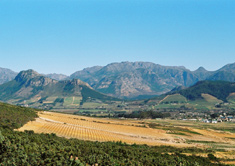 The R700-million Fransche Hoek wine estate development was a key part of the deal that secured funding to establish the Mooiwater farm as low-cost settlement for former squatters
The R700-million Fransche Hoek wine estate development was a key part of the deal that secured funding to establish the Mooiwater farm as low-cost settlement for former squatters
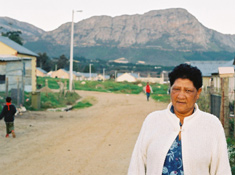 Half of Mooiwater's residents are people evicted from farms in the 1990s - including Janiera Blankenberg
Half of Mooiwater's residents are people evicted from farms in the 1990s - including Janiera Blankenberg





